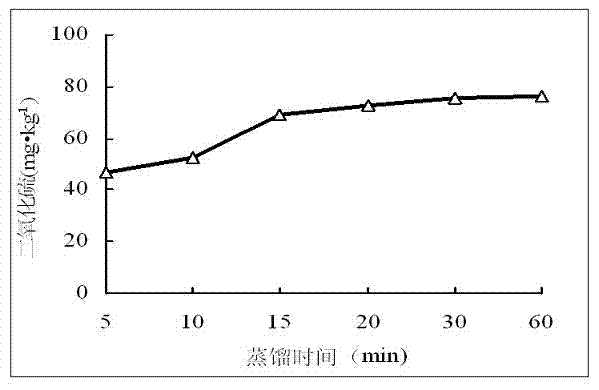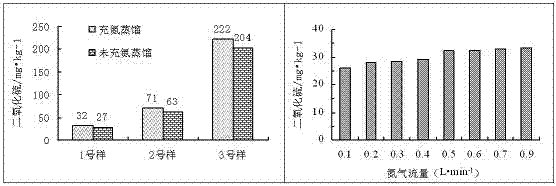Method for detecting sulfur dioxide in plant-derived food
A sulfur dioxide, plant-derived technology, applied in the measurement of color/spectral characteristics, etc., can solve the problems of dark color and interference measurement, and achieve the effect of reducing environmental pollution
- Summary
- Abstract
- Description
- Claims
- Application Information
AI Technical Summary
Problems solved by technology
Method used
Image
Examples
Embodiment 1
[0070] 1. Instruments and reagents:
[0071] Instrument: UV-3802 spectrophotometer (Unocal Shanghai Instrument Company), flow meter (0.1L min -1 ~1.0L·min -1 ), HP4 ceramic heating plate (German IKA company).
[0072] Reagents: water is distilled water or deionized water, hydrochloric acid solution (1+1); sodium hydroxide solution (weigh 6g sodium hydroxide, dilute with water to 100mL; cyclohexanediaminetetraacetic acid disodium solution (weigh 1.82g1, 2-cyclohexanediaminetetraacetic acid, add 6.5mL of sodium hydroxide solution, dilute to 100mL with water); formaldehyde buffer absorption solution stock solution (weigh 2.04g potassium hydrogen phthalate, dissolve in a small amount of water, add formaldehyde solution 5.5 mL, disodium cyclohexanediaminetetraacetic acid solution 20mL, diluted with water to 100mL); formaldehyde buffer absorption solution (dilute the formaldehyde buffer absorption solution stock solution 100 times with water); 0.05% pararosaniline hydrochloride co...
Embodiment 2
[0080] 1. Sample processing
[0081]Accurately weigh 2g of crushed black fungus and place it in a 250mL flask. Measure 10mL of 1+1 hydrochloric acid solution into the dropping funnel of the device, measure 20mL of 0.05% formaldehyde buffer absorption solution into the absorption bottle and 50mL volumetric flask, connect it to the distillation device, and adjust the nitrogen flow rate to 0.5L / min ~0.6L / min. Add 50 mL of deionized water into the weighed sample flask, immediately put it back into the distillation device, and put the hydrochloric acid solution in the dropping funnel into the flask. Adjust the temperature of the temperature-controlled ceramic electric heating plate to 500°C, boil the contents in the flask, and keep boiling for about 30 minutes. Remove the absorption bottle, transfer the absorption solution into a volumetric flask, rinse with formaldehyde buffer absorption solution, and make up to volume. At the same time, do a blank experiment.
[0082] 2. Samp...
Embodiment 3
[0085] 1. Sample processing
[0086] Accurately weigh 0.2 g of crushed lily and place it in a 250 mL flask. Measure 10mL of 1+1 hydrochloric acid solution into the dropping funnel of the device, measure 20mL of 0.05% formaldehyde buffer absorption solution into the absorption bottle and 50mL volumetric flask, connect it to the distillation device, and adjust the nitrogen flow rate to 0.5L / min ~0.6L / min. Add 50 mL of deionized water into the weighed sample flask, immediately put it back into the distillation device, and put the hydrochloric acid solution in the dropping funnel into the flask. Adjust the temperature of the temperature-controlled ceramic electric heating plate to 500°C, boil the contents in the flask, and keep boiling for about 30 minutes. Remove the absorption bottle, transfer the absorption solution into a volumetric flask, rinse with formaldehyde buffer absorption solution, and make up to volume. At the same time, do a blank experiment.
[0087] 2. Sample ...
PUM
| Property | Measurement | Unit |
|---|---|---|
| wavelength | aaaaa | aaaaa |
| absorbance | aaaaa | aaaaa |
| recovery rate | aaaaa | aaaaa |
Abstract
Description
Claims
Application Information
 Login to View More
Login to View More - R&D
- Intellectual Property
- Life Sciences
- Materials
- Tech Scout
- Unparalleled Data Quality
- Higher Quality Content
- 60% Fewer Hallucinations
Browse by: Latest US Patents, China's latest patents, Technical Efficacy Thesaurus, Application Domain, Technology Topic, Popular Technical Reports.
© 2025 PatSnap. All rights reserved.Legal|Privacy policy|Modern Slavery Act Transparency Statement|Sitemap|About US| Contact US: help@patsnap.com



